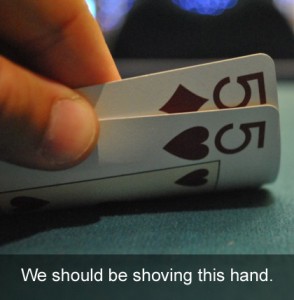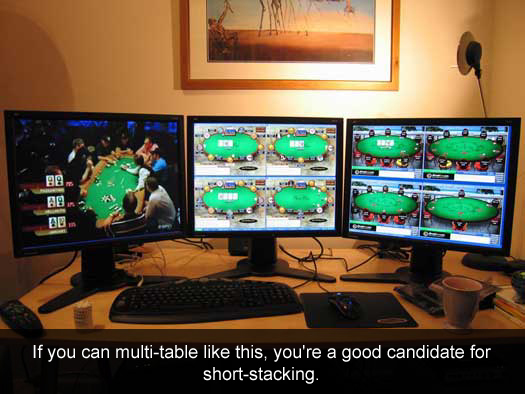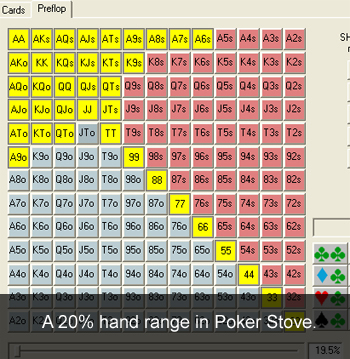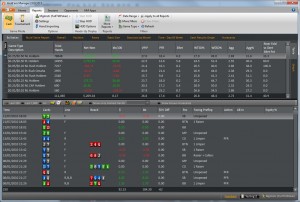 Becoming more and more essential to your poker arsenal, understanding the dynamic concepts associated with stack sizes can be the difference between winning and losing hundreds (or thousands) of dollars. It’s possible to be a winning player and not fully comprehend the challenges inherited with changing stack sizes, but it’s by no means ideal. In order to move your way up the rungs of the poker ladder, ambitious poker professionals and amateurs alike have taken the time to calculate and digest the in-and-outs of short-stacking and deep-stacking.
Becoming more and more essential to your poker arsenal, understanding the dynamic concepts associated with stack sizes can be the difference between winning and losing hundreds (or thousands) of dollars. It’s possible to be a winning player and not fully comprehend the challenges inherited with changing stack sizes, but it’s by no means ideal. In order to move your way up the rungs of the poker ladder, ambitious poker professionals and amateurs alike have taken the time to calculate and digest the in-and-outs of short-stacking and deep-stacking.
Poker’s general landscape is one that’s primarily mathematical, but in some situations finding an exact solution is either extremely complicated or impossible to calculate. Thankfully, within that formulaic environment is scattered both physical and heuristic ideas players can use to further progress their understanding. However, with short-stack play, because of its limited complexity players can use the variables they have at their disposal to find out exactly what the best play is. We will be covering short-stacked play in as much detail as possible in this strategy article.
Deep-stacked play, on the other end of the spectrum, is much less mathematical. While all of poker has certain math components, many of those associated with deep-stacked play are similar or exactly the same as in a typical 100bb buy-in game. There’s just bigger numbers. Because of this, we’ll be touching on some fundamental deep-stack modifications, but with much less involvement.
Going in, I’m hoping that you’re fairly comfortable with pot odds, implied odds, reverse implied odds and maybe a touch of “game theory”. All in all, we won’t be explaining why we’ve decided to raise particular hands, or many other basic situations that we’re assuming you already know. Now that we’ve covered that, let’s get to it.
Try your poker game at some of the best online poker sites around – for US players play at Bovada.lv, and for non-US players, try your game at 888poker.com
Breaking Down Stack Sizes to a Science
As we’ve said prematurely, stack sizes have a way of fundamentally changing the dynamic of a poker game. Because most poker sessions involve players who buy-in for at least 100 big blinds, adding in a few players who have bought in for the minimum (30 big blinds for most live games and 20 big blinds online) can change the game in ways that are less than desirable. On the other end, having chip stacks that are well above the standard buy-in (200-250+ big blinds) can also change the strategy of play at a table. While the former is a bit more problematic than the latter, it becomes a bit easier to counteract once you understand some of the principles behind short-stacked play.
So why do short-stackers play short-stacked?
For those who may be aloof or inexperienced, once you begin playing a lot of poker you’re frequently going to encounter short-stacked players. There are three different types of short-stackers:
1. Players who originally bought in for a full-stack and haven’t reloaded;
2. Players who bought in for the table minimum, or less than or equal to 30 big blinds, but have little to no idea of a short-stack strategy;
3. Players who are playing a sound, effective short-stack strategy
The most common trait between the three types of players is obviously their stack size. More often than not, players have decided to play short-stacked because of their inexperience, or reluctance to get involved for big sums of money. Being realistic, there is no reason for an intelligent winning player to be playing for less money; we’ll end up winning less from our sessions and minimize our overall expectation. However, the third type of player is the one we’ll need to worry about.
Opponents who have decided to buy-in for small amounts and play a good short-stack strategy will make our lives difficult. While short-stacking can mean winning less, those who are able to multi-table well can increase their expectation dramatically, negating the generic argument of greater full-stack EV. Because they don’t have to worry about reverse-implied odds (because of their stack size), and the bigger stack sizes (such as us) will have to be concerned about the other bigger stacks getting involved in the pot with us, it makes our decisions tricky. In example: If we started with 100bbs and decided to raise with a suited connector in the CO, a short-stack on the button could call, the SB fold and the BB with 300bbs behind elect to call also. If this occurred, our stack could now be at risk because of the BB.
For players playing with short-stackers, it will be necessary for us to spot and categorize which of the players in our game are playing a sound short-stack strategy, and which players are not. This will allow us to make the best decisions whenever we’re in a hand with a short-stacker.
Depending on where we play (online or live), we should be on the lookout for short-stacked players. In the live setting, because casinos don’t spread limits lower than $1/2, we will frequently come across more short-stacked players who fit into the first two categories. Think about it: Because 200NL is the lowest limit you can play, many beginners flock to the game, and many of those beginners won’t be inclined to gamble for the maximum. Therefore, their best option is to buy-in for the minimal amount, or close to it. On the other hand, in online play there are so many more limits available that truly the only reason you would be buying in for less than the minimum is because you’re used to the action at a certain stake, or you’re a short-stack specialist. We’re not saying that you’ll never find a bad short-stacker online; they’re just much less common.

Short-stacked Play
We know what short-stackers are, and how to define some of their characteristics. But what is it about short-stacked play that we hate so much?
Well, short-stackers are bad because they allow us to win much less money. By going all-in, which is their primary move, they force players with bigger stack sizes to either fold (earning their initial raise or limp), three-bet for an enormous amount, or call (leaving ourselves vulnerable to any aggressive players left to act). Even worse, most short-stackers (and nearly all professionals) will get up from the table after doubling up through other players. Because of their preference to play shallow, once they’ve started building or possess a playable stack, they’re gone before you can blink your eyes. Because of this, we’re now incapable of gaining our edge (and money) back.
But what if we know what a short-stacker is trying to do to us? That’s where we can use our smarts to actually out-smart a short-stacker at their own game. It’s clear that short-stacking has its advantages. By playing shallow, short-stackers utilize two important components:
- Fold Equity – making their opponents release their hand before showdown;
- Forcing Mistakes – because of a short-stacker’s aggressiveness, they inspire bad calls from us allowing them to make money
Although short-stackers have the option to call a raise from another player, good short-stackers rarely do this because of the limited options it gives post flop. In a quick example: You’re playing 200NL online with a stack of $250. It’s folded to you and you decided to raise $6 with [Ad 5d] in the cut-off. The button and small blind folded, and a 20bb short-stacker in the big blind calls. The pot is now $13. A great situation for a full-stacked player; the short-stack only has $34 behind and we can put them all-in on just two streets of betting. If the short-stacker misses the flop, they will be reluctant to continue, allowing their opponent to make money effortlessly.
To avoid this situation, they instead go all-in or fold. With this aggressiveness, and because the re-raise of 20bbs is a big raise, players instinctively fold more often, feeding the short-stacker. However, as we’re going to examine, this will be a big mistake. Although it’s possible for a short-stacker to have a premium holding, let’s remember that using that big re-raise as a fold tactic is their primary weapon – doing this with only 5-10 percent of hands would be both too obvious, and not sustainable as the blinds come to them.
However, their opponents can also make donations to them by calling their shoves far too lightly. By calling with any two cards, you’ll be a significant underdog in many situations and will still add to their bottom line.
What we need to do is find a nice balance, and more importantly pay attention to what hands they’re playing in order to counter them. Furthermore, making a few smaller adjustments to our playing style will also be very effective. Since the general adjustments use less math (and work for us), let’s look at those first.
Try your poker game at some of the best online poker sites around – for US players play at Bovada.lv, and for non-US players, try your game at 888poker.com
General Adjustments
Looking at short-stack strategy as a whole, since these players will be shoving a lot, we’ll consequently have to fold more often. While this is a great result for them, it’s not ideal for us. But to minimize this loss, we should make the necessary adjustment of shrinking our raise size. If we’re normally raising 3-4bbs, we should consider lowering this to 2-2.5bbs if we’re against short-stackers. This is even more essential if a short-stacker is to your immediate left, or close to your immediate left. This is done because now when they shove over our raises, they’ll win less from us.
Another great adjustment to make when facing short-stacked players is to tighten up your raising range. Since we’ll constantly be facing an all-in bet from a short-stacker, we’ll want our range to be weighted towards hands we can easily call with, without being dominated. Obviously, the stronger our range, the better. NOTE: We don’t want to take this adjustment too far. If we make the mistake of being too tight, especially in late position, we’ll still be missing value even from a short-stacker. The reason is easy to see – short-stacked players will still fold a lot to late position raises because they don’t want to call and see a flop. Because of their stack size, our advantageous position, and limited maneuverability, this is less than desirable for them. Many of them will fold, or make a mistake themselves by shoving over our raises too lightly. Both results are good for us, and this will be one of our best ways to counter their strategy.
Three-betting Short-stackers
To put this into perspective, consider what happens when we’re 3-bet by a full-stacked player rather than a short-stacker. If we’re 3-bet by a regular, when we’re also full-stacked or even deep we’ll now have the opportunity to win an entire stack if we elect to call. This is because our implied odds are much greater against them; having hands that develop on later streets favor wider opening ranges and deeper stacks. On the contrary, if we are to raise widely against a 20bbs stack, we’ll only be able to win 20bbs maximum. You won’t be able to bluff often, if ever, because they’ll be all-in before the flop. Our pot odds are diminished, and so is our fold equity.
Let’s not forget that since good short-stackers will maximize fold equity, they’ll also need to make raises themselves. In earlier positions, it’s likely that they’ll have a tight enough range where you won’t have to make many adjustments. But in late position, short-stackers should and will be active, because after all raising in the cut-off or the button and winning the blinds is a significant increase to their stack size. In fact, it’s an 8 percent increase to a 20bbs stack. Because of this, we’ll also need to formulate a strategy to balance against this form of aggression. If you’ve played a lot of poker, you’ll probably understand that defending your blinds is significant.
We could call against a short-stacker’s raise, however, we likely won’t get to showdown cheaply because of the effective stack size, and we won’t have much fold equity being out of position with the stack-to-pot ratio. Instead, we should be making many more three-bets. By 3-betting, we give ourselves the opportunity to pick up the pot then and there, or hopefully eliminate the short-stacker altogether by winning the pot at showdown.
Let’s look at what may happen if we three-bet:
- The short-stacker folds to our raise, enabling us to win a small pot.
- The short-stacker calls our raise, giving us better fold equity + initiative.
- The short-stacker 4-bets us, and we’re able to make an easy call given the limited stack size.
- The short-stacker calls our raise, and another full-stacked player 4-bets.
The last of the options is easily the most difficult, simply because many smart players would recognize what we’re doing and use our aggression against us by elaborating on this plan even further. We also don’t know whether or not the full-stacked 4-bettor is making a play on us, or actually has a real hand (looking at HUD stats or notes would also help us with this dilemma).
In order to achieve the same effect and limit the effectiveness of a 4-bet, we should definitely shrink our 3-bet size. If our normal 3-bet is to something like 12bbs, let’s lessen that number to something more modest; maybe 9 or 10bbs. By doing so, we’ll be involved in a less risky situation against another full-stacked player if they elect to call, we can fold and avoid losing more if we’re 4-bet, and if the short-stacker calls or 4-bets, we’ll be in a pot-committed situation! All simple, and cost-effective EV decisions!
However, the three first options are ripe for making money against short-stackers. But when we decide to 3-bet a short-stacker, what hands should we be doing this with? Obviously, we won’t want to 3-bet with any hand, or with a range that’s too tight. Instead, if we can we would prefer to tailor our play directly to a short-stacker’s late position raising range, thus exploiting them specifically and minimizing their value. (We say minimize because great short-stackers may still have a tiny edge against us if they play an equilibrium or optimal strategy.) However, if a short-stacker is too passive, or isn’t playing optimally, is quite possible that we can beat them at their own game by shoving against their raises with the appropriate percentage of hands.
In order to calculate this we’re going to have to do some math.
Upon doing these calculations, I think it’s best we look at a situation in which we’re the pre-flop raiser, and the short-stacker has 3-bet all-in from the big blind – this will be one of the most common situations we will encounter.
To call a short-stacker’s raise, we’ll want to know their shoving range. Since this is a very specific instance, if we’re playing online, we can use our database program (Hold’em Manager, Poker Tracker, etc.) to find some of the optimal shoving ranges from good short-stacked opponents. If you have lots of hands on this particular opponent, well even better. For this example we’re going to first calculate how much equity we need, then make a reasonable estimate (from my experience) of the range a good short-stacker would shove with in your typical 6-max online 200NL game.
To do this, we’ll need to solve an EV equation for our equity in this spot (we’ll use the variable E for equity):
 200NL
200NL
Our hand: Any two cards
Everyone has folded to us on the button. We raised to $6. The small blind folded, and the short-stacked big blind shoves for $40.
There’s our info. Let’s quickly do the math now by solving for E.
EV of calling: [(Equity) x (Total size of the pot)] – (Our cost to call)
EVcall : [(E) x ($85)] – ($34)
EVcall : [85E] – 34
EVcall : 34 = 85E
EVcall : 34/85 = E
EVcall : 0.4 = E
So by solving for E, we found that the minimal amount of equity we’ll need to call a shove from our opponent in this situation is 40 percent.
In order for that information to be the most useful, however, we should note that we need the actual shoving range for our short-stacker. As I stated, you can use the online statistics you’ve gathered through your database manager to come up with an accurate range. But for this example, we’ll use the estimate of a 20 percent shoving range, which is probably on the modest side. A 20 percent hand range could consist of the following hands:
66+, A4s+, K8s+, Q9s+, J9s+, T9s, A9o+, KTo+, QTo+, JTo
This hand range isn’t set in stone, and often times opponents will have 20 percent hand ranges that vary from what is listed. Nonetheless, the difference is a matter of degree, and altering the composition of such a hand range (at the sake of intense accuracy) won’t have much of an effect on our calling range and decision. As long as you call with hands that are ≥ 40 percent, you’ll be in good shape. Use a computer program such as Poker Stove to find these hand ranges. It may look something like this:
66+, A4s+, K8s+, QTs+, A2o+, KTo+, QJo
So what we’ve found is that by solving for E, or the EVcall = 0, we found out the range of hands that will minimize our short-stacker’s shove value. I know what you’re thinking – it won’t be much use at the poker table in-game, or that maybe the math is a bit difficult. In fact, it’s simple algebra, and if you take the time away from the tables to analyze some short-stackers’ hand ranges, you’ll be able to call all-ins effectively and profitability; one of our biggest goals in poker. Hey, you may even begin to deter these players from playing a short-stack strategy at all!
To keep things simple, we won’t go too far into what happens in the reverse situation: A short-stacker opens and we are the re-raiser. Doing the math is very similar; instead we’ll just be solving this equation for EVraise. We will need to have our probability of being called (which we can estimate using the information we gather from our short-stacker), and then insert our hand’s equity vs. that range.
Try your poker game at some of the best online poker sites around – for US players play at Bovada.lv, and for non-US players, try your game at 888poker.com
Post-Flop Play With Short-Stackers
Fortunately for us, because of the stack-to-pot ratio, in most situations post-flop we’ll be making easy decisions. Almost any time we make top pair or better, and sometimes even worse, we’ll be going all-in without trepidation. In these instances our hands are far too strong, and we’re pot-committed.
However, there will be some instances with which we’ll miss the flop, or we’ll have a draw. Even in these situations we’ll still be going all-in. Of course, we’re mentioning the spots where you’ll be heads-up against the short-stacker. If the hand is multi-way, we’ll need to adjust accordingly.
To summarize situations in which you have air, or have a strong draw: You’ll be looking to both use your immediate equity, and also maximize fold equity. The easiest way to do this, is to make the last raise. What I mean by this, is that in spots where you’re out of position, you’ll be checking, preparing to check-raise if your opponent bets, or you’ll be checking back in position trying to raise your opponent on a later street. Some intelligent readers may ask… well won’t we need to balance? Of course we’ll need to. If we only bet or raise when we have air or a draw, we would be extremely exploitable, and our opponent would counter this by calling lighter. So we’ll have to mix in some value hands to deceive our villain, and allow him to make tougher decisions.
Deep-Stacked Play
While deep-stacked play isn’t trivial, it’s not nearly as formulaic as short-stacked play can be. However, if you’re not paying attention, you can make some costly mistakes.
For those who are looking to improve their deep-stack proficiency, you’ll want to work on three important characteristics:
- Widening your hand selection;
- Playing more hands in position;
- Avoiding second-best hands
When you move to deeper stacks (stacks of at least 175+bbs), you should begin to understand that the value of strong hot-and-cold hands (AA, KK, QQ, etc.) goes down considerably, and the value of implied odds hands (suited aces, suited connectors, etc.) goes up. It’s not that premium pocket pairs and high-card combinations are useless; it’s just that without help they can cost us a ton of money because our other deep-stacked opponents won’t be folding if they’ve hit something they think can win our entire stack.
If we instead widen our hand selection, we’ll now allow ourselves to draw to straights, flushes and sets which should make it easy to get all-in on the right boards. It will be unlikely that our opponents have stronger hands than us, and even if they do make a strong hand on the flop, we can draw to a better one later.
 As we’ve said, we’ll want to play hands like T9s-65s, a ton of suited aces (if not all), and many small-to-medium pocket pairs hoping to make a set.. Of course, we’ll still be playing our big pairs; however, we’ll need to lessen our aggression should we encounter resistance, especially multi-way on dangerous or wet boards.
As we’ve said, we’ll want to play hands like T9s-65s, a ton of suited aces (if not all), and many small-to-medium pocket pairs hoping to make a set.. Of course, we’ll still be playing our big pairs; however, we’ll need to lessen our aggression should we encounter resistance, especially multi-way on dangerous or wet boards.
By playing more hands in position we’ll give ourselves the chance to draw as cheaply as possible, and simultaneously make profitable decisions because we’ll already have seen our opponents act. It will also allow us to control the size of the pot – a characteristic that will benefit us greatly as the stacks get deeper and more significant.
Avoiding second-best hands sounds easy to do, but in practice it can be difficult. Raising hands such as the [Kd Td] or [Js 8s] will still be hidden if you flop two pair or make trips, however in hands where you make a straight or a flush you have to be worried about bigger hands on the turn and river if you encounter aggression. Long story short: It’s good to always be drawing to the nuts, or near-nuts. By playing pots with drawing hands like A2s or 76s, you’ll either make a nut hand, or you’ll have a hand that you can likely get away from. You’ll need this type of flexibility against the stronger players.
Hopefully this will help you conquer short-stack and deep-stack poker cash games. Now go crush.
Good luck, and hopefully I’ll see you at the tables.

Comments are closed.